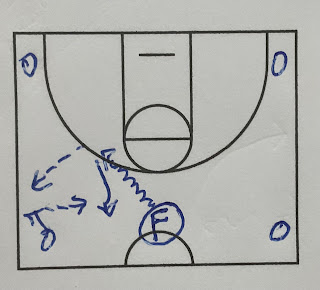Throughout the history of the game of basketball, coaches have wanted to use a strategy of “stalling” or “delaying” if they were to get a lead. According to the book, The Real Hoosiers, in the 1930’s it was not unusual for a team to have the lead at the beginning of the second half and hold the ball for the entire second half.
One of the most famous delay tactics was used by Dean Smith at North Carolina in 1977. Phil Ford used the “four corners” office when Carolina got the lead. With “four corners,” Ford handled the ball with each of his teammates in one of the corners of the half-court. Ford would dribble and eventually pass to a teammate. After he passed, he would run and get it back. Shortly after this strategy was developed, rule makers introduced the shot clock.
Rules makers have constantly come up with rules to prevent the “delay” tactic. One of the first rules was the development of the 10 second line that required the offense to get the ball over half-court within 10 seconds. Legend has it that in a Knox College vs Lombard College game, the ball was inbounded and the team caught it and held the ball in the backcourt. Both teams just stood and eventually sat. The legend is that the school band eventually played the National Anthem so the players at lead had to stand.
In 1957, one of the most famous games in Galesburg High School’s history involved the use of a “delay” offense from the very beginning of the game. Galesburg had a starting line up with Al Williams at 6’1” as the tallest player, where as Rock Island had height, including future NBA player, Don Nelson. Rock Island was ranked #6 in Illinois and Galesburg was unranked. Rock Island had beaten Galesburg twice. So when they met in the Sectional Championship game at Wharton FH, Coach John Thiel chose to use his “open court.” The Streaks bolted out to a 2-0 lead after one quarter on their way to winning 23-21.
Coach John Thiel’s “open court,” involved putting the forwards in the corners and the guards out front. The guards played catch and dribbled. If the guards got in trouble, the forwards popped up, caught a pass, and the guard jumped back toward them to get a pass back. The post was in the lane but always moved to stay out of the way of a driving guard.
Alignment of the 1956 team.
Albert Kimbrough drives at the basket, so Al Williams moves out of the way.
Bobby Hoffman is dribbling and dribbling and dribbling. In 1957 there was no five second call on a dribbler, so even if they were closely guarded, the player could dribble as long as they wanted.
Bobby Hoffman is in trouble so Elbert Kimbrough pops up to get the ball. Hoffman passes the ball and immediately pops over to get the ball back.
Bobby Hoffman drives to the basket, Elbert Kimbrough’s defender slides into the lane to help. Hoffman passes out to Elbert Kimbrough then goes out to get the ball.
Bobby Hoffman drives, Al William’s defender slides over to help. Hoffman dumps the ball to Williams for an easy layup.
North Carolina’s four corner offense with Phil Ford as the “F.” Ford drives and when double teamed, he passes the ball, but goes and gets the ball back.
North Carolina’s four corners was set up to keep the entire lane area open for players to be able to drive or to cut backdoor.
Galesburg’s “open court” put three players along the baseline area so that the area from free throw line to half-court only had two offensive players. With the rules in the 1950’s where a player could keep dribbling or holding the ball for more than 5 seconds even if closely guarded, the Galesburg “open court” gave the two guards plenty of space to move and to dribble around. And in this case, both Hoffman and A. Kimbrough were good ball handlers.












No comments:
Post a Comment